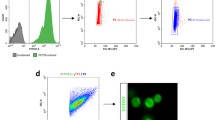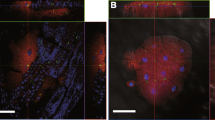Abstract
Over the past few decades, various techniques have been developed and optimized for the accurate measurement of RNA abundance in cells or tissues. These methods have been instrumental in gaining insight in complex systems such as host–symbiont associations. The pea aphid model has recently emerged as a powerful and experimentally tractable system for studying symbiotic relationships and it is the subject of a growing number of molecular studies. Nevertheless, the lack of standardized protocols for the collection of bacteriocytes, the specialized host cells harboring the symbionts, has limited its use. This chapter provides a simple, step-by-step dissection protocol for the rapid isolation of aphid bacteriocytes. We then describe an adapted protocol for efficient extraction and purification of bacteriocyte RNA that can be used for most downstream transcriptomic analyses.
Access this chapter
Tax calculation will be finalised at checkout
Purchases are for personal use only
Similar content being viewed by others
References
Liu S, Trapnell C (2016) Single-cell transcriptome sequencing: recent advances and remaining challenges. F1000Res 5
Wang Z, Gerstein M, Snyder M (2009) RNA-Seq: a revolutionary tool for transcriptomics. Nat Rev Genet 10:57–63
Bing X, Attardo GM, Vigneron A et al (2017) Unravelling the relationship between the tsetse fly and its obligate symbiont Wigglesworthia: transcriptomic and metabolomic landscapes reveal highly integrated physiological networks. Proc Biol Sci 284:20170360
Hansen AK, Moran NA (2011) Aphid genome expression reveals host-symbiont cooperation in the production of amino acids. Proc Natl Acad Sci U S A 108:2849–2854
Luan JB, Shan HW, Isermann P et al (2016) Cellular and molecular remodelling of a host cell for vertical transmission of bacterial symbionts. Proc R Soc Lond B Biol Sci 283:20160580
Simonet P, Gaget K, Balmand S et al (2018) Bacteriocyte cell death in the pea aphid/Buchnera symbiotic system. Proc Natl Acad Sci U S A 115:E1819–E1828
The International Aphid Genomics Consortium (2010) Genome sequence of the pea aphid Acyrthosiphon pisum. PLoS Biol 8:e1000313
Shigenobu S, Watanabe H, Hattori M et al (2000) Genome sequence of the endocellular bacterial symbiont of aphids Buchnera sp. APS. Nature 407:81–86
Rabatel A, Febvay G, Gaget K et al (2013) Tyrosine pathway regulation is host-mediated in the pea aphid symbiosis during late embryonic and early larval development. BMC Genomics 14:235
Sapountzis P, Duport G, Balmand S et al (2014) New insight into the RNA interference response against cathepsin-L gene in the pea aphid, Acyrthosiphon pisum: molting or gut phenotypes specifically induced by injection or feeding treatments. Insect Biochem Mol Biol 51:20–32
Simonet P, Gaget K, Parisot N et al (2016) Disruption of phenylalanine hydroxylase reduces adult lifespan and fecundity, and impairs embryonic development in parthenogenetic pea aphids. Sci Rep 6:34321
Simonet P, Duport G, Gaget K et al (2016) Direct flow cytometry measurements reveal a fine-tuning of symbiotic cell dynamics according to the host developmental needs in aphid symbiosis. Sci Rep 6:19967
Acknowledgments
This work was supported by the Institut National des Sciences Appliquées-Lyon, Institut National de Recherche pour l’rAgriculture, l’Alimentation et l’Environnement, and French National Research Agency Program Grant ANR-16-CE02-0014-03 (Hmicmac: Host-microbiota co-adaptations, mechanisms and consequences). M.R.L. and P.S. were awarded PhD fellowships by the French Ministry of Research. The authors would like to thank the Hirox Company for their help in image acquisition with the RH-2000 digital microscope.
Author information
Authors and Affiliations
Corresponding authors
Editor information
Editors and Affiliations
Rights and permissions
Copyright information
© 2021 Springer Science+Business Media, LLC, part of Springer Nature
About this protocol
Cite this protocol
Ribeiro Lopes, M. et al. (2021). Isolation of Insect Bacteriocytes as a Platform for Transcriptomic Analyses. In: Jin, H., Kaloshian, I. (eds) RNA Abundance Analysis . Methods in Molecular Biology, vol 2170. Humana, New York, NY. https://doi.org/10.1007/978-1-0716-0743-5_13
Download citation
DOI: https://doi.org/10.1007/978-1-0716-0743-5_13
Published:
Publisher Name: Humana, New York, NY
Print ISBN: 978-1-0716-0742-8
Online ISBN: 978-1-0716-0743-5
eBook Packages: Springer Protocols




